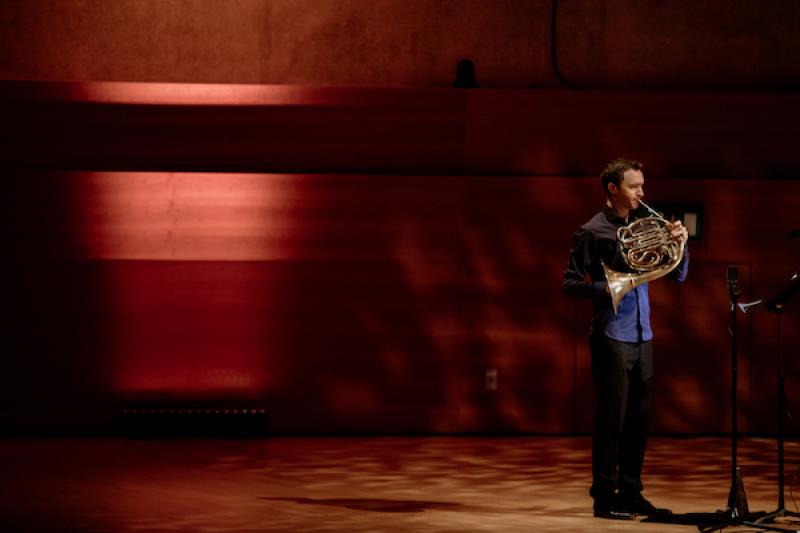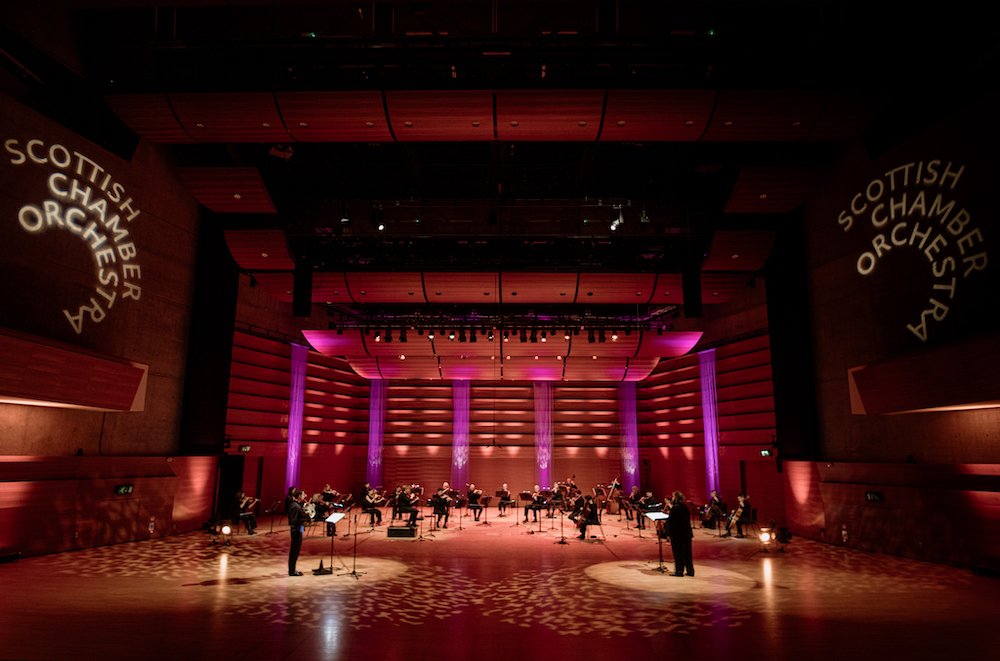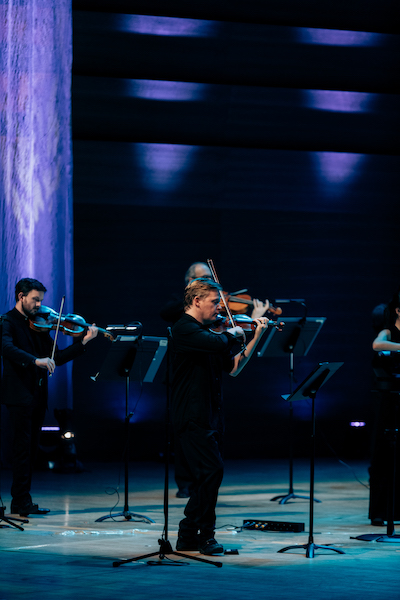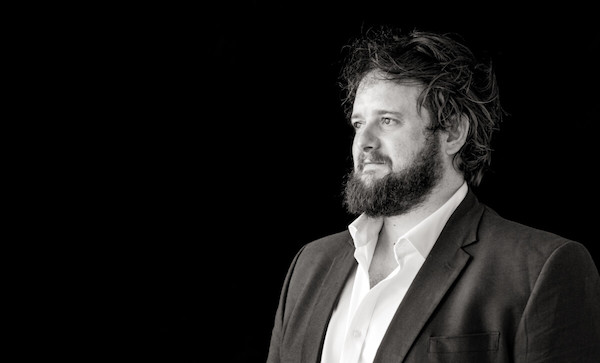Clayton, Frank-Gemmill, SCO, Kuusisto online review – small but beautifully formed | reviews, news & interviews
Clayton, Frank-Gemmill, SCO, Kuusisto online review – small but beautifully formed
Clayton, Frank-Gemmill, SCO, Kuusisto online review – small but beautifully formed
Music of style and substance presented in an enticing online package

After a brief interlude of concerts with a live audience, we are back to streamed events from empty halls (though many venues in London will be opening up again from next Thursday, concerts in Scotland have never opened up to the public). Some ensembles have opted to
It’s also noticeable that the production values of broadcasts like last night’s are becoming impressive. Multiple cameras, well edited, straightforward but warm presentation by cellist Su-a Lee and a pretty impressive sound considering it was on YouTube (I had the HD settings on) made for an enjoyable experience, and the programme was wisely kept to under an hour. There was a brief conversation between the principals between the two pieces, but this was unforced, fluent, and genuinely insightful, without the badgering of a presenter. I have been listening to Anna Clyne’s music quite a lot recently as the recently released album Mythologies is an excellent survey of her orchestral music, and its embrace of both filmic pizzazz and contemporary edge. Within Her Arms is apparently Clyne’s most performed piece, although not one I’ve heard before, and from what I can tell (and slightly surprisingly) not yet commercially recorded. Written for Esa-Pekka Salonen and the LA Phil, it commemorates Clyne’s mother, who died suddenly in 2008.
I have been listening to Anna Clyne’s music quite a lot recently as the recently released album Mythologies is an excellent survey of her orchestral music, and its embrace of both filmic pizzazz and contemporary edge. Within Her Arms is apparently Clyne’s most performed piece, although not one I’ve heard before, and from what I can tell (and slightly surprisingly) not yet commercially recorded. Written for Esa-Pekka Salonen and the LA Phil, it commemorates Clyne’s mother, who died suddenly in 2008.
It is a 14-minute elegy for 15 strings, using small melodic fragments often in canon, movingly expressing Clyne’s grief. Occasionally a more extended melody emerges, but it is mostly a study in texture. There are hints of Tippett in the close string counterpoint, the ghost of Scottish folksong in the modality and echoes of Arvo Pärt in the music’s single-minded pursuit of an idea.
 The charismatic Finn Pekka Kuusisto (pictured left) directed from the violin, doing most of his work with his eyes, sometimes pulsing with his violin and at the very end conducting with his bow in graceful wave. The players, spaced, facing each other in ranks, captured the lamenting flavour of the music with its low centre of gravity, and soared in the impassioned, intricate climax.
The charismatic Finn Pekka Kuusisto (pictured left) directed from the violin, doing most of his work with his eyes, sometimes pulsing with his violin and at the very end conducting with his bow in graceful wave. The players, spaced, facing each other in ranks, captured the lamenting flavour of the music with its low centre of gravity, and soared in the impassioned, intricate climax.
If the Clyne has quickly established a reputation in the decade since its composition, the other piece has been acknowledged as a stone-cold classic for over half a century. Britten’s Serenade brought together Kuusisto, who has worked with SCO for almost 20 years, their former principal horn Alec Frank-Gemmill and the brilliant tenor Allan Clayton.
Frank-Gemmill started the prologue in the dark, a spotlight gradually emerging. He and Clayton were facing the string players, augmented in number, and although everyone was spaced this arrangement allowed for good communication, probably better than would have been possible in a standard concert hall with everyone facing in the same direction.
 Allan Clayton (pictured above by Sim Canetty-Clarke) cut a slightly dishevelled, somewhat Grimesian figure, extravagantly bearded but sounding divine. He characterised the music with his usual incisive, mercurial manner, one moment a twinkle in his eye, the next a demonic glare. The interaction with Frank-Gemmill was gripping: “Blow, bugle, blow” was issued as an instruction that just had to be obeyed. The “Elegy” became an operatic recitative, Clayton unleashing the full power of his voice, but it is essentially an essay for the horn, Frank-Gemmill finding warmth in the low register and wonderfully metallic glissandos at the very end.
Allan Clayton (pictured above by Sim Canetty-Clarke) cut a slightly dishevelled, somewhat Grimesian figure, extravagantly bearded but sounding divine. He characterised the music with his usual incisive, mercurial manner, one moment a twinkle in his eye, the next a demonic glare. The interaction with Frank-Gemmill was gripping: “Blow, bugle, blow” was issued as an instruction that just had to be obeyed. The “Elegy” became an operatic recitative, Clayton unleashing the full power of his voice, but it is essentially an essay for the horn, Frank-Gemmill finding warmth in the low register and wonderfully metallic glissandos at the very end.
The effortless invention of each movement, their succinctness and economy of means, make for joyful music-making even when the subject matter is dark. But Kuusisto is a boyish, mischievous presence, always finding new things in the string writing. There were certainly moments – like the extrovert “Hymn” and the “Epilogue” – where I really missed being in the room, the sound on speakers simply unable to capture the thrill of feeling the horn notes vibrating in the same air. But as the final notes faded into the distance I was just glad of the opportunity to see and hear fine musicians playing such extraordinary music.
rating
Explore topics
Share this article
The future of Arts Journalism
You can stop theartsdesk.com closing!
We urgently need financing to survive. Our fundraising drive has thus far raised £49,000 but we need to reach £100,000 or we will be forced to close. Please contribute here: https://gofund.me/c3f6033d
And if you can forward this information to anyone who might assist, we’d be grateful.

Subscribe to theartsdesk.com
Thank you for continuing to read our work on theartsdesk.com. For unlimited access to every article in its entirety, including our archive of more than 15,000 pieces, we're asking for £5 per month or £40 per year. We feel it's a very good deal, and hope you do too.
To take a subscription now simply click here.
And if you're looking for that extra gift for a friend or family member, why not treat them to a theartsdesk.com gift subscription?
more Classical music
 Kilsby, Parkes, Sinfonia of London, Wilson, Barbican review - string things zing and sing in expert hands
British masterpieces for strings plus other-worldly tenor and horn - and a muscular rarity
Kilsby, Parkes, Sinfonia of London, Wilson, Barbican review - string things zing and sing in expert hands
British masterpieces for strings plus other-worldly tenor and horn - and a muscular rarity
 From Historical to Hip-Hop, Classically Black Music Festival, Kings Place review - a cluster of impressive stars for the future
From quasi-Mozartian elegance to the gritty humour of a kitchen inspection
From Historical to Hip-Hop, Classically Black Music Festival, Kings Place review - a cluster of impressive stars for the future
From quasi-Mozartian elegance to the gritty humour of a kitchen inspection
 Shibe, LSO, Adès, Barbican review - gaudy and glorious new music alongside serene Sibelius
Adès’s passion makes persuasive case for the music he loves, both new and old
Shibe, LSO, Adès, Barbican review - gaudy and glorious new music alongside serene Sibelius
Adès’s passion makes persuasive case for the music he loves, both new and old
 Anja Mittermüller, Richard Fu, Wigmore Hall review - a glorious hall debut
The Austrian mezzo shines - at the age of 22
Anja Mittermüller, Richard Fu, Wigmore Hall review - a glorious hall debut
The Austrian mezzo shines - at the age of 22
 First Person: clarinettist Oliver Pashley on the new horizons of The Hermes Experiment's latest album
Compositions by members of this unusual quartet feature for the first time
First Person: clarinettist Oliver Pashley on the new horizons of The Hermes Experiment's latest album
Compositions by members of this unusual quartet feature for the first time
 Gesualdo Passione, Les Arts Florissants, Amala Dior Company, Barbican review - inspired collaboration excavates the music's humanity
At times it was like watching an anarchic religious procession
Gesualdo Passione, Les Arts Florissants, Amala Dior Company, Barbican review - inspired collaboration excavates the music's humanity
At times it was like watching an anarchic religious procession
 Classical CDs: Camels, concrete and cabaret
An influential American composer's 90th birthday box, plus British piano concertos and a father-and-son duo
Classical CDs: Camels, concrete and cabaret
An influential American composer's 90th birthday box, plus British piano concertos and a father-and-son duo
 Cockerham, Manchester Camerata, Sheen, Martin Harris Centre, Manchester review - re-enacting the dawn of modernism
Two UK premieres added to three miniatures from a seminal event of January 1914
Cockerham, Manchester Camerata, Sheen, Martin Harris Centre, Manchester review - re-enacting the dawn of modernism
Two UK premieres added to three miniatures from a seminal event of January 1914
 Kempf, Brno Philharmonic, Davies, Bridgewater Hall, Manchester review - European tradition meets American jazz
Bouncing Czechs enjoy their Gershwin and Brubeck alongside Janáček and Dvořák
Kempf, Brno Philharmonic, Davies, Bridgewater Hall, Manchester review - European tradition meets American jazz
Bouncing Czechs enjoy their Gershwin and Brubeck alongside Janáček and Dvořák
 Solomon, OAE, Butt, QEH review - daft Biblical whitewashing with great choruses
Even a top soprano and mezzo can’t make this Handel paean wholly convincing
Solomon, OAE, Butt, QEH review - daft Biblical whitewashing with great choruses
Even a top soprano and mezzo can’t make this Handel paean wholly convincing
 Two-Piano Gala, Kings Place review - shining constellations
London Piano Festival curators and illustrious friends entertain and enlighten
Two-Piano Gala, Kings Place review - shining constellations
London Piano Festival curators and illustrious friends entertain and enlighten
 Echo Vocal Ensemble, Latto, Union Chapel review - eclectic choral programme garlanded with dance
Beautiful singing at the heart of an imaginative and stylistically varied concert
Echo Vocal Ensemble, Latto, Union Chapel review - eclectic choral programme garlanded with dance
Beautiful singing at the heart of an imaginative and stylistically varied concert

Add comment